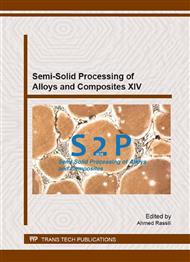p.119
p.126
p.133
p.139
p.146
p.153
p.175
p.181
p.186
Behaviour of Semisolid Slurry Flows through a Channel
Abstract:
In case of metal sheet forming of alloys in semisolid state, modelling of the process is very essential to predict flow behaviour, temperature distribution of the alloy etc. towards improvement of the product quality and to reduce manufacturing costs. Accordingly, the present work develops a model to predict the behaviour during metal sheet forming of an Al-alloy (A356) in semisolid state. The semisolid alloy passes through a rectangular channel having small depth and larger width. The alloy in semisolid state is cooled from the top at a controlled rate. In the model, the respective flow field is represented by the momentum conservation equation. The non-Newtonian behaviour of the semisolid slurry is incorporated considering the Herschel–Bulkley model. The agglomeration and de-agglomeration phenomena of the suspended particles under shear are represented using a time dependent structural parameter. The temperature field is predicted considering the transient energy conservation equation, and hence the fraction of solid is continuously updated. The solution considers an apparent viscosity of the semisolid alloy as a function of structural parameter, shear stress and shear rate. The governing equations are finally solved by finite difference method. The work predicts velocity, temperature and liquid fraction distribution of the semisolid slurry.
Info:
Periodical:
Pages:
146-152
Citation:
Online since:
September 2016
Authors:
Price:
Сopyright:
© 2016 Trans Tech Publications Ltd. All Rights Reserved
Share:
Citation:


